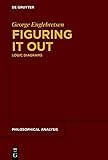Figuring It Out : Logic Diagrams / George Englebretsen.
Material type: TextSeries: Philosophical Analysis ; 78Publisher: Berlin ; Boston : De Gruyter, [2019]Copyright date: ©2020Description: 1 online resource (XIV, 220 p.)Content type:
TextSeries: Philosophical Analysis ; 78Publisher: Berlin ; Boston : De Gruyter, [2019]Copyright date: ©2020Description: 1 online resource (XIV, 220 p.)Content type: - 9783110621631
- 9783110621846
- 9783110624458
- 160.223 23
- BC136 .E457 2020
- online - DeGruyter
- Issued also in print.
| Item type | Current library | Call number | URL | Status | Notes | Barcode | |
|---|---|---|---|---|---|---|---|
 eBook
eBook
|
Biblioteca "Angelicum" Pont. Univ. S.Tommaso d'Aquino Nuvola online | online - DeGruyter (Browse shelf(Opens below)) | Online access | Not for loan (Accesso limitato) | Accesso per gli utenti autorizzati / Access for authorized users | (dgr)9783110624458 |
Frontmatter -- Contents -- List of Figures -- Preface -- 1. Introduction: Seeing Reason -- 2. Some Historical Figures -- 3. Lines of Reason -- 4. Holding the Line -- 5. Linear Diagrams and Non-Classical Quantifiers -- 6. Drawing Conclusions: Get Better Diagrams -- Bibliography and Further Reading -- Index
restricted access online access with authorization star
http://purl.org/coar/access_right/c_16ec
Many systems of logic diagrams have been offered both historically and more recently. Each of them has clear limitations. An original alternative system is offered here. It is simpler, more natural, and more expressively and inferentially powerful. It can be used to analyze not only syllogisms but arguments involving relational terms and unanalyzed statement terms.
The book begins with an extensive survey of the history of logic diagrams, including looking at possible diagrams from Aristotle, the development of both linear and closed figure diagrams by Leibniz, Lambert, Euler, Venn’s new system, Peirce’s Existential Graphs, and Frege’s two-dimensional notation as a kind of logic diagram system. During most of the 20th century, there was little regard for efforts to construct logic diagrams. However, since the 1980s there has been an increasing interest in such diagrams. Ever larger numbers of philosophers, logicians, mathematicians, computational scientists, and cognitive scientists have turned their attention to building, analyzing, using, or exploring in other ways systems of logic diagrams. The system offered here makes use of line segments and points and it enjoys a number of important advantages: it is simple, natural, and both expressively and inferentially powerful. It can be used to analyze syllogisms (including those involving relational terms) and arguments involving unanalyzed statements. Understanding such a system can shed valuable light on how ordinary people naturally reason.
Issued also in print.
Mode of access: Internet via World Wide Web.
In English.
Description based on online resource; title from PDF title page (publisher's Web site, viewed 28. Feb 2023)


